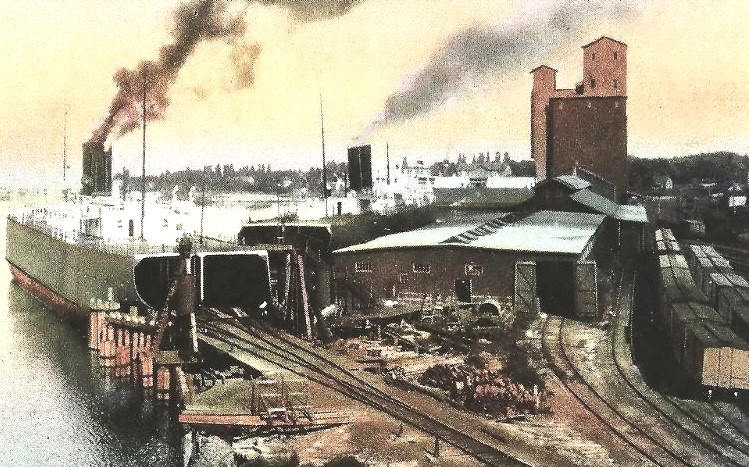- Details
- Hits: 787
Location: Ludington, MI - F&PM Lake Docks & Boats
 The Flint & Pere Marquette railway maintained up to five cross-lake boats in the 1890's, bringing passengers, railroad cars and other bulk freight back and forth between the docks at Ludington and the ports of Milwaukee and Manitowoc.
The Flint & Pere Marquette railway maintained up to five cross-lake boats in the 1890's, bringing passengers, railroad cars and other bulk freight back and forth between the docks at Ludington and the ports of Milwaukee and Manitowoc.
Image info: Top, an early colorized view of the Pere Marquette dock at Ludington, including warehouses, a grain elevator and two vessels.
Notes
Time Line
1893. March 25. Though hindered to some extent through snow and ice, the F&PM railway company's boats running between Ludington, Milwaukee and Manitowoc have carried an immense amount of freight since navigation [through the straits] closed last fall. Owing to the lower rates of lake transportation companies during the season of navigation, nearly all the flour, millstuffs and grain shipped from Milwaukee and Manitowoc to eastern points takes the all-water route to Buffalo and other lower lake ports, but as soon as the straits are closed in the fall the F&PM boats are kept constantly on the move with full loads and only with the advent of spring does the rush end. The company owns five boats in all, four of which are passenger and freight steamers with a carrying capacity of about forty cars each, while the fifth is a first-class modern freighter of over 1,200 tons burden.
Some idea may be formed as to the amount of business done by them when it is known that during three months from December 1892 to March 1, 1893, the five boats carried an aggregate of 4,000 cars of eastbound freight, 1,400 cars of which were grain in bulk amounting to 1,236,000 bushels, the remainder being mostly flour and millstuffs. In addition to this they carried over 1,000 cars of west-bound merchandise and many thousand barrels of salt for western points. Three hundred men are employed during the winter season in the freight sheds of the company at Ludington, work being carried on most of the time, night and day. These boats carry no insurance except against fire, and the losses sustained by them have been very light. [DFP-1893-0326]
1971. November 4. Car ferry operations came to a complete halt when the C&O exhausted its coal supply because of the long coal strike. After the coal ran out, the C&O obtained from the ICC an order allowing it to divert Lake Michigan traffic to other carriers. The order was to expire December 15 but the C&O resumed train ferry operations on December 11 with two ships. The impact of the shutdown was near catastrophic for the area. Nearly 500 are employed by the C&O in Ludington and the monthly payroll is estimated near the $325,000 mark. [LDN-1972-0114]
1972. January. An investigation by the ICC has begun to determine if the Chesapeake Ohio railway is intentionally diverting traffic from its train ferry operation between Ludington and Wisconsin ports. The ICC stated that they were particularly interested in a directive that the C&O had issued to the C&NW and Soo Line that no more than 10 loads of freight per day be interchanged to the C&O in Milwaukee.
It was noted that as of December 31, the C&O's Jones Island train ferry yard in Milwaukee was rerouting 31 loads and 27 empties around the lake. In Ludington, the C&O yards rerouted 14 loads and eight empties. Traditionally, the C&O lays up part of the fleet during the two-week period of the Christmas holiday because of the cutback in auto production and general letdown of business.
C&O officials have been quick to point out that the train ferry is not a money-maker for the company. The company points to the large number of men needed to man a single ship, especially when compared to a train crew. However, the car ferries carried 197,162 passengers and 61,665 autos in 1971. Those figures are low because last spring the dock at Jones Island was out and service could not be provided to Milwaukee. The ICC noted that just because they have started an investigation, it in no way means the agency agrees or disagrees with the charges made. [LDN-1972-0114]
Bibliography
The following sources are utilized in this website. [SOURCE-YEAR-MMDD-PG]:
- [AAB| = All Aboard!, by Willis Dunbar, Eerdmans Publishing, Grand Rapids ©1969.
- [AAN] = Alpena Argus newspaper.
- [AARQJ] = American Association of Railroads Quiz Jr. pamphlet. © 1956
- [AATHA] = Ann Arbor Railroad Technical and Historical Association newsletter "The Double A"
- [AB] = Information provided at Michigan History Conference from Andrew Bailey, Port Huron, MI

